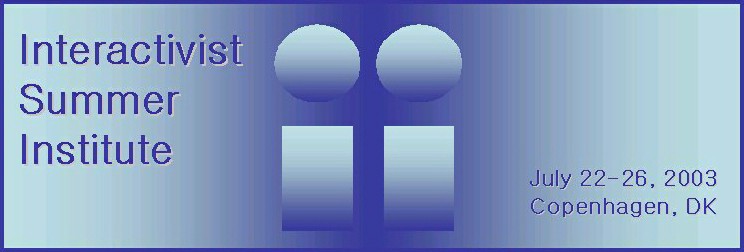
Interactivist Summer Institute
July 22 - 26, 2003
Copenhagen
IETAL, MASIVE, POPSICLE… The Sequence…
Goran Trajkovski1 and Georgi Stojanov2
1Computer and Information Sciences Department, Towson University
8000 York Rd, Towson, MD 21252-0001, USA, E-mail: gtrajkovski@towson.edu
2Computer Science Department, Faculty of Electrical Engineering
PO Box 574, Skopje, MK-1000, Macedonia, E-mail: geos@cerera.etf.ukim.edu
The problem of learning has been a central notion in the Artificial Intelligence theories of Agency for a long time. In the past several years my research team has established and studied IETAL (Interactivist-Expectative Theory on Agency and Learning), as a part of the growing trend in re-approaching two very different disciplines, Robotics, on one side and Developmental Psychology, on the other. IETAL Theory concentrates on exploring the concepts of learning in an autonomous agent, through interaction with the environment it inhabits. In the process the agent develops intrinsic models of their environment with a relevant emotional context for a given set of active drives.
The project MASIVE (Multi-Agent Systems Interactive Virtual Environments) is the IETAL multi-agent extension. In addition to learning and adopting throughout the interaction with the environment, the agents also interact between themselves. They are equipped with special sensors for sensing akin agents, and interchange their knowledge during their imitation convention sessions. In addition, MASIVE investigates the social dimensions of the intraagent interaction from the perspective of learning, social structures, knowledge dissemination, and emergence of language in multi-agent society.
POPSICLE (Patterns in Orientation: Pattern-Aided Simulated Interaction Context Learning Experiment) represents an IETAL/MASIVE empirical investigation, designed to explore the use of the inborn schemas in humans, as well as their use of contextual information. The experiment uses a simple 5x5 maze with obstacles, colored in different colors. The goal (food, water) is placed in a single place in this environment. Normally, following a one-color path takes the subject to a place where a particular drive (hunger, thirst) can be satisfied. In different stages of the experiment, different amount of information is presented to the subject (specific instructions, selected portions of the environment). Throughout the various stages of the experiment, the human agent sees either only the color of the square they are currently on (context 0), or that color and the color of the adjacent squares (context 1) in the four directions (North-East-South-West).
The paper will discuss this sequence of research efforts, present the results, and the directions for further work.
